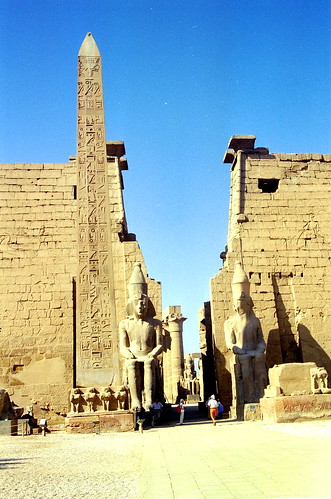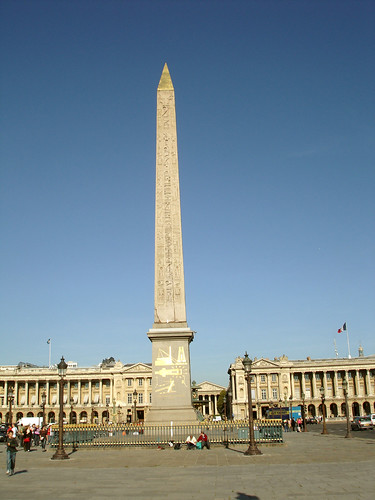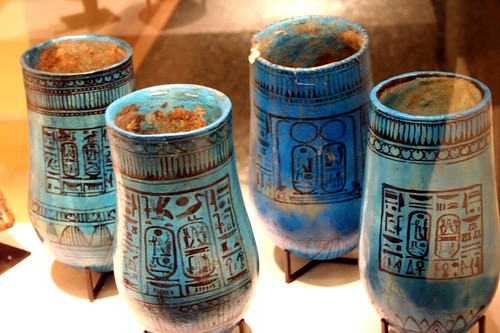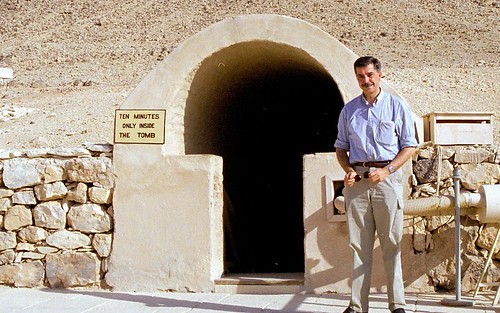
Cargado el 5 de noviembre, 2009
Galería de Hans Ollermann
King Ramses II (also called Ramses the Great) 1279-1212 B.C.

1998 28 Obelisk van Ramses II voor de Luxor tempel, Egypte
02 To the left: the obelisk of Ramesses II in front of the Luxor Temple, Egypt.
To the right: only the socle for the second obelisk, that is now decorating the Place de la Concorde in Paris (--> 01).

2005_1027_144058AA Obelisk van Ramses II op de Place de la Concorde, Parijs
01 This granite obelisk of Ramesses II is 23 m. high and 3300 years old. In 1833 Mohammed Ali - viceroy of Egypt - donated this monument from the temple in Luxor to king Louis-Philippe of France. It is one of a pair. The other one is still situated in front of the Temple in Luxor.

2005_1026_120808AA Vazen met de naam van Ramses II, 1279-1213 BC,Louvre
Vases with the name of Ramesses II, Louvre

2005_1026_120821AA Vazen met de naam van Ramses II, 1279-1213 BC,Louvre
Vases with the name of Ramesses II, Louvre

1998 31 Entree tot de tombe van koningin Nefertari, vrouw van Ramses II
Here the favourite wife of Ramesses II was burried
Comentarios
Lenka P Dice:
Hans Ollermann  dice:
dice:
As you know, even the sarcophagus in wich Ramesses II was found, was not is own, it was a lent one.
The mummy of Ramses II is real, for sure. It causes lots of problems, as you will have read in the papers. When Ramses II arrived in Paris in the official aeroplane of the French president,
in order to be conservated, a doctor cut some hair of the mummy as a personal souvenir. Now Egypt wants the man persecuted and the lock of hair back.
Louvre’s jars never held the organs of Rameses II
Hola Joan,
Preguntabas por el inicio al culto de Apis/Serapis y creo que el problema radica en unir a ambas divinidades. Apis está documentado en la piedra de Palermo pero los primeros enterramientos de toros sagrados en el llamado serapeum pertenecen a la dinastía XVIII. Sin embargo el culto a Serapis se inaugura en el período Ptolemaico , concretamente bajo el reinado de Ptolomeo I y no antes, con objeto de crear una divinidad que fundiera deidades egipcias (Osiris y Apis) bajo el molde iconográfico griego para obtener una divinidad más cercana y "entendible" en aquellos momentos.
Hay un libro que puede ayudarte a aclarar estos temas y es el siguiente:
T.A. BRADY: "Serapis & Osiris". Ares Publishers. Chicago 1978
No sé si he aclarado algo o te he liado aún más.
Un saludo
Elisa Castel
(Madrid, España)
http://www.egiptologia.com/religion-y-mitologia/
| # | Título del artículo | Autor | Hits | |
| 1 | La pluma de Maat. Aspectos del vínculo conceptual e iconográfico | Susana Alegre García | 6803 | |
| 2 | Maat: El hombre y el orden del mundo en el Antiguo Egipto | Ildefonso Robledo Casanova | 3678 | |
| 3 | El culto de Amón en Nubia | Elisa Castel | 10367 | |
| 4 | La cosmogonía y la enéada heliopolitana | Elisa Castel | 1677 | |
| 5 | El Toro Apis | Adriana Manrique Madrid | 1434 | |
| 6 | Acerca de la iconografía de NFRT-IMNTT, la personificación del Oeste en la Religión Egipcia Antigua | Prof. Jorge Roberto Ogdon | 2138 | |
| 7 | Acerca de la iconografía del Dios Min | Prof. Jorge Roberto Ogdon | 4514 | |
| 8 | Notas sobre Set como Serpo-Asno y los ofidios multiformes | Prof. Jorge Roberto Ogdon | 2571 | |
| 9 | Origen y personalidad de la Serpiente-Rerek en los textos de los sarcófagos | Prof. Jorge Roberto Ogdon | 3262 | |
| 10 | El Termino Maat | Margarita Flores | 4355 | |
| 11 | Atón: Politeísmo y Monoteísmo | Rosa Mª Bustos Ramos | 6468 | |
| 12 | La religión funeraria: Osiris | Rosa Mª Bustos Ramos | 4182 | |
| | ||||
| | ||||
| | ||||
##########################################
RSS Feed de Amigos de la Egiptología
http://www.egiptologia.com/index.php?format=feed&TYPE=rss
##########################################
Galería de Imágenes sobre el Antiguo Egipto
http://www.egiptologia.com/imagenes
Recomendamos: Instituto Valenciano de Egiptología
http://www.ivde.org/
--------------------------------------------------------------
LISTA DE DISTRIBUCIÓN DE AMIGOS DE LA EGIPTOLOGÍA - AE
Gestión Altas-Bajas y consulta mensajes enviados:
http://www.egiptologia.com/lista-de-distribucion.html
Moderador: Víctor Rivas egiptologia@egiptologia.com
Amigos de la Egiptología: http://www.egiptologia.com
Los mensajes de Amigos de la Egiptología son distribuidos gracias al apoyo y colaboración técnica de RedIRIS Red Académica Española - http://www.rediris.es
| Uno de los temas más complejos de la civilización egipcia es el entendimiento de las herramientas y del complejo mecanismo de su forma de entender el mundo en todas sus vertientes. Todo esto es especialmente dificil cuando afrontamos su pensamiento desde un punto de vista puramente grecorromano, completamente diferente al que tuvieron los habitantes del Egipto faraónico. En este apartado se incluirán aquellos artículos que sirvan para ir desgranando sus concepciones. | |

